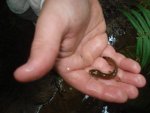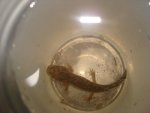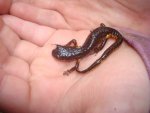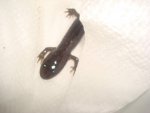My apologies. I had not reviewed the herping account policies regarding locality and such. I will repost with specifics deleted.
I took 6 kids from the ages of 9 to 4 years of age on a two day field herping expedition. We had a blast. We explored an ecosystem with cold creeks and redwoods. Very moist area even for summer time. Plus 3 of the 6 kids are from Las Vegas, Nevada(my niece and nephews) and therefore have never seen a salamander up close.
On day one we found an Ensatina which I believe to be a hybrid intergrade of the E.e.oregonesis X E.e.platenus. I have Pertersen's field guide and that's was the best fit according to the guide. I also believe I found 2 R. variegatus larva sharing a particularly slow part of a creek. Could have been just very young D. tenebrosus. To round out day one we found a B. attenuatus.
On day two we started off finding a definate E.e.picta and then another hybrid within 5 meters of it near some seepage. Then we explored another cold water creek and found about 7 D. tenebrosus larva throughout the day. I did find an interesting mix of sizes in one prime spot on the creek. I found 3 D. tenebrosus larva all about 5 inches in length co-habitating with 3 more that were only about 2 inches long.
Took pictures. Lots of learning on this trip.
I took 6 kids from the ages of 9 to 4 years of age on a two day field herping expedition. We had a blast. We explored an ecosystem with cold creeks and redwoods. Very moist area even for summer time. Plus 3 of the 6 kids are from Las Vegas, Nevada(my niece and nephews) and therefore have never seen a salamander up close.
On day one we found an Ensatina which I believe to be a hybrid intergrade of the E.e.oregonesis X E.e.platenus. I have Pertersen's field guide and that's was the best fit according to the guide. I also believe I found 2 R. variegatus larva sharing a particularly slow part of a creek. Could have been just very young D. tenebrosus. To round out day one we found a B. attenuatus.
On day two we started off finding a definate E.e.picta and then another hybrid within 5 meters of it near some seepage. Then we explored another cold water creek and found about 7 D. tenebrosus larva throughout the day. I did find an interesting mix of sizes in one prime spot on the creek. I found 3 D. tenebrosus larva all about 5 inches in length co-habitating with 3 more that were only about 2 inches long.
Took pictures. Lots of learning on this trip.








